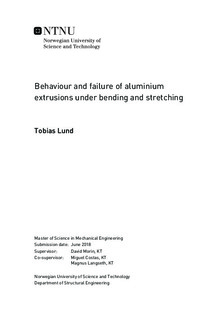| dc.description.abstract | Current and future strategic challenges in the construction industry require safe and lightweight structures to achieve a good strength to weight ratio. Authentic material combinations together with numerical simulations are urgently needed to reduce development time and to remain competitive. Aluminium provides favourable strength to weight ratio, low density and high resistance to corrosion. In addition, it is recyclable and flexible as it can be processed in different ways, e.g. casting, extrusion and rolling. Properly applied, aluminium alloys are competitive to other structural materials such as steel.
Aluminium extrusions supplied by Hydro Aluminium were used as an example to investigate failure behaviour. Fibrous- and recrystallised microstructure were investigated for an AA6005A-T6 alloy under combined bending and stretching loads and axial crushing simulations. The material model for the aluminium alloy were established using a damage regularisation scheme for shell elements. This model assesses the elements deformation mode based on the thinning strain rate of the through-thickness gradient. Input data for the finite element models and stretch bending and crash simulation were generated through quasi-static material tests. For an initial validation of the material models, the quasi-static tests were simulated with very good correlation of the results. From the quasi-static uni-axial tensile tests, the materials strain data was accumulated using a digital image correlation analysis with the software eCorr. This data was processed, and the material characteristics were described using Hooke s law, Hershey-Hosford yield criterion, an associated flow, extended Voce law and Cockroft-Latham failure criterion. From these procedures material cards for both the alloy with fibrous- and the recrystallised microstructure were implemented for use in Abaqus/Explicit.
Experimental- and numerical results for the quasi-static stretch bending and axial crushing were separately discussed and compared. The validity of the numerical model and its ability to replicate the physical experiments were reviewed and how different features affected the results considered. Components yielded high reproducibility within each test setup and only minor deviations in the material behaviour and failure characteristics were observed. Consequently the constitutive model ability to replicate the test results were examined.
The combined bending and stretching loads, and axial loads for both test setups were reproduced in the simulation models with high accuracy. The models ability to replicate a more complex deformations with complex stress states and severe bending were decisive to conclude that the constitutive numerical models were able to predict failure accurately. A parameter sensitivity study was performed on the numerical models, evaluating mesh dependency, boundary conditions and fillet contribution. The increased bearing capacity added by the fillets had small effect on the result, and only a minor variation were caused by use of symmetry planes. With a coarser mesh, the accuracy of the numerical model decreased.
In this Thesis it was proven that aluminium extrusions could be sufficiently simulated by means of finite element methods under bending and stretching loads as well as in axial crushing situations utilising the damage regularisation scheme. However, some discrepancies were found between the numerical- and experimental result, particularly for the fibrous material model. Further work should include an introduction of an anisotropic yield criterion as the material exhibited anisotropic behaviour. | en |

